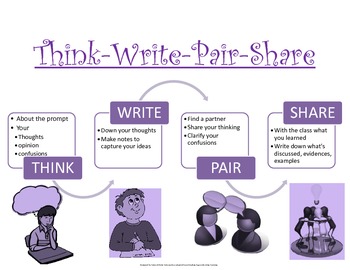

Tanner (2021) Reconsidering the Share of a Think-Pair-Share: Emerging limitations, alternatives, and opportunities for research. Mertz (2021) What type of debrief is best for learning during Think-Pair-Shares? Teaching Learning Inquiry 9:45-60.Ĭooper, K. Saeed (2020) Assessing the effects of agree/disagree circles, exit tickets, and Think-Pair-Share on Students’ academic achievement at undergraduate level.

Alternatively, you can eliminate the Share portion of the activity if all the learning goals are achieved via using just Think-Pair as a technique (Cooper et al.
#Think pair share full
To lessen these concerns, instructors can modify the Share aspect of the TPS to include warm calling (ask students if they are willing to share and only call on them if they are willing), local sharing (using Square instead of Share and thus only having small group discussions), or full participation (all pairs share their ideas during the class discussion Cooper et al. 2021).Īdditionally, the methods used for the Share aspect of the TPS can become problematic if the whole class discussion lacks the richness of ideas found in the pair discussion, is dominated by a subset of students, or uses approaches to participation that create inequalities or cause anxiety in students (Cooper et al. For example, research found students given application questions over recall questions during TPS activities had significantly higher test scores on course exams regardless of the format for whole class discussion (Barrett et al. The main structure for TPS relies on the question prompt (both question type (multiple-choice, open-ended questions, etc.) and cognitive level (recall, application, analysis, etc.)) given to students, but also in how pairs are used and the strategy for whole class discussion. The structure used to implement TPS can greatly impact the learning of students. Usually, Think-Pair-Share takes between 5-10 minutes for students to complete if only part of the class shares their ideas during the Share portion of the activity. The amount of time required for TPS varies greatly depending on the topic or question prompt (with broader topics or open-ended questions requiring more time), the format for sharing (all pairs share or only selected pairs share during the class discussion), and any alterations of the structure of the activity (for example, using Think-Pair-Square-Share by adding an additional step (Square) where two pairs join together to share as a small group before moving on to the class discussion (Share)).

TPS can activate prior knowledge when used at the beginning of class or aid in student retention of information through reflection if used at the end of the class (Akhtar and Saeed 2020).

TPS can be used at any time during a lecture and usually only requires a few minutes to implement. And compared to traditional lecture only formats, the addition of TPS increases student learning and retention of course concepts (Gok 2018, Akhtar and Saeed 2020, Barrett et al. Using TPS allows students time to process information in a structured format while also increasing cooperation and inclusion as all students participate in discussing the question or topic (Gok 2018, Akhtar and Saeed 2020, Farr et al.


 0 kommentar(er)
0 kommentar(er)
